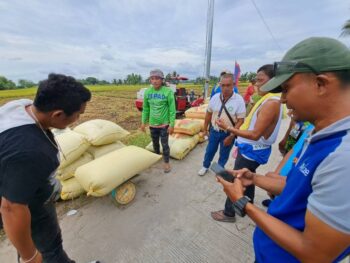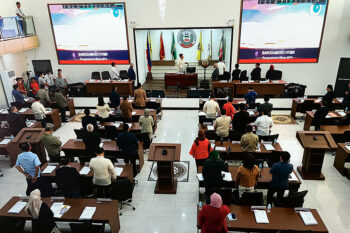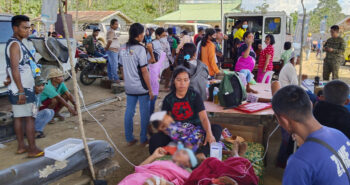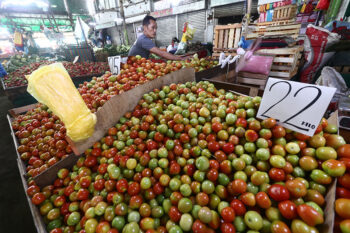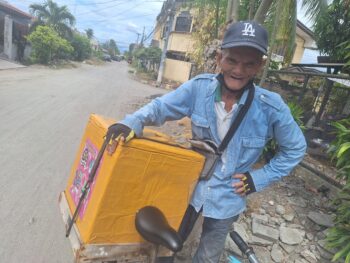
(Can’t Go Out and Other Stories)
Author: Ms. Elizabeth Joy Serrano-Quijano
Published by: Ateneo Publication Office, Ateneo de Davao University
Once upon a time – actually only about half-a-century ago – when we were kids growing up in Digos which was then a typical small town in Davao, our quotidian life was punctuated by simple joys and innocent pursuits to the point of being mundane. But not knowing how kids in urban centers lived their lives, we were content with how life unfolded in the rural setting and we made the most of it in the company of friends in the neighborhood.
Growing up in a rustic location where farms – planted mainly to coconut and corn – encircled the small poblacion, we often find the time to help gather coconuts ready for extracting copra or harvesting the corn. Or stealing some of the corn ready to be roasted as anagon. Sometimes we earned a bit of money which made possible buying candies at the Chinese store, or renting komiks at a small shack beside our school.
As we lived near the river, practically all the days of our summer break was spent swimming in its cold waters while our mothers washed clothes. Lunch – no matter how simple as just rice, bulad and ginamos – was always delicious if eaten when we were very hungry after all the horsing around the river. But our mothers would warn us not to swim on Fridays as the dili-ingon-nato were displeased with all the noise children made and could lead to contracting a disease that can only be cured by the neighborhood’s herbularyo. But of course there were times when we disobeyed them; when caught lying, we got a good beating from our fathers.
The small town was location for all kinds of stories and narratives, some of which were the product of gossip. Even with us children, such stories would filter into our conversations as to who was courting who, who were committing adultery, who was pregnant outside of wedlock, who was losing money from too much gambling in the cockpit, whose children were constantly beaten by their fathers but no one would ever dare intervene and who were those who were so enamored with their money no one can ever borrow money from them.
But there were also stories bordering on the magical and superstitious which we children loved hearing from older folks especially when there was a full moon hovering. There were stories of engkantos, including beautiful women who could seduce bachelors who are never seen again, of the aswang who would eat the liver of children, of the ungo who could take on the shape of a pig, and of the multos of those who died in problematic circumstances and would appear walking around the neighborhood during midnight. There was an old man who lived at the edge of the town all by himself who hardly inter-acted with the rest of the community except when he sold his produce in the market. Word was that he was a magbabarang and for a fee would accept clients.
These were the years long before a Marcos appeared in the political landscape when it was the Quirinos, Magsaysays and Garcias who were the country’s leaders. Elections were generally peaceful and buying votes was unheard of. Corruption in government bureaucracy did not make millionaires of public officials. There were no rebels hiding in the nearby mountain range, there were no indigenous communities being dislocated as they could easily move further to the forests if they exchanged their land to migrant-settlers who paid for the land with salt and sardines, and no evacuations resulting from Moro-Christian skirmishes.
While our families’ income were barely enough for our daily needs, nonetheless, there would be no word about any family going hungry. For there was always a way to find food. Public school education was relatively cheap, so most of us could go to school, except those living across the river and nearby barrios which made it difficult to attend classes every day. Or if the children were expected to help out with their families’ farms.
So generally – despite conflicts between neighbors and married couples – we lived a peaceful life. Children could play in the streets at night up till they are called to come home. Generally everyone respected each other’s properties. Neighbors shared their farms’ produce or what mothers cooked. Fiestas were always well celebrated as the households made sure to raise pigs that could then be roasted on the patron’s feast day. Through the Church’s system of assigning godparents to children being baptized, confirmed and when young couples were married, the kumare-kumpare system helped to cement cordial relations among neighbors
But the town of Digos where I grow up, is no longer what it was when we were kids. So also most of the small towns – from Mati to Tagum to Bansalan – which have been transformed into semi-urbanized cities. Everyday life has radically changed as populations, business enterprises and transport facilities increased. People are caught in a faster pace of living their lives trying to catch up with the demands of livelihood and responsibilities. There seems to be none of the carefree days of yore.
But while reading Ms. Elizabeh Joy Serrano-Quijano’s DILI PWEDE MOGAWAS UG UBANG MGA SUGILANON (CAN’T GO OUT AND OTHER STORIES), I realized that what used to be my town’s reality was still mirrored by what Serrano-Quijano experienced as a child, two generations later. Since she is only in her late 30s, her growing up in the small town of Matan-ao (also in Davao del Sur) was very recent. As has been asserted by post-colonial literary theorists, the best writings these days are done at the periphery. Those who actually are immersed in their respective local settings are the best writers to articulate the realities of such settings. This book allows the reader to enter into the specific context of the stories with all its entertaining but also heartbreaking particularities.
Serrano-Quijano was born and grew up in Matan-ao among her extended clans of Blaans, the town’s original inhabitants. Among the characters of her stories are family members and relatives, as well as neighbors, teachers, childhood friends and persons with interesting lives. Even as these are stories that may be read separately, these are interlinked within the framework of how the town’s events unfolded. It almost is an autobiographical work by an author that has found her unique voice and positioned herself as one of the exciting young writers of Mindanao who can claim indigenous roots. Being an indigenous woman, who finished a college degree and now holds an important post in her school, a mother with children and managed to have attended writing workshops – Serrano-Aquino has her own unique identity that serves her well in her pursuit of being a writer.
This book – written in Cebuano-Bisaya (of the colloquial language that has evolved in Mindanao) – is an anthology of 10 short stories whose locus is her Matan-ao. As many prospective readers may not be able to understand this language, or those who could but find it cumbersome to read in this language, the author and her publisher decided to have English translations of the stories. Fortunately, John Bengan of UP-Mindanao – a published author himself and co-member of the Davao Writers’ Guild – was willing to do the English translations. Bengen claims that he tried “to stay close to Serrano-Quinajo’s rhythm by following her own arrangement of words – or at least similar to the syntax in Cebuano. Her plainspoken but concise sentences keep this goal within reach.” Perhaps, later she could also produce works in her own mother tongue.
I found myself feeling nostalgic as I read the essays as there are many parallels between our everyday life in Digos 50 years ago and what the author experienced almost two generations later. There are indeed, so many similarities: the patterns of livelihood of peasants, the games children play, the gossips circulating in the town, the stories bordering on the magical and superstitious and what concerned parents regarding their children’s future. Characters in these stories – the Chinese businessman, the beggar, the adulterer, the wronged wife, the older person considered strange and the kind neighbors – seem to be always present in the life of small towns.
The story – Ako si Robin Nabaro – is about a beggar who the story teller claims to be a lazy bum when he is fit enough to work. Gambalas Ago is the story of what the wronged wife whose husband was rumored to impregnate a store owner in the town would do to avenge her herself. Kasiawa is about the Chinese businessman who at one time had the biggest store but eventually went bankrupt. The horror stories include Ang Buntis gikan Zamboanga about the soul of a pregnant woman – offered in a ritual to seek a favor from the spirits – who appears to children. Pikpik is the storyteller’s reference to a possibility that she got sick and needed hospitalization owing to a curse by someone who tapped her shoulder. And in Abogmaya, the old woman who lived by herself was believed to be a witch.
However, there is also a world of difference given the political and economic developments that have taken place in Mindanao and across the country since the Marcos regime and in the post-EDSA era. While growing up in Matan-ao, the author experienced the repercussion of the revolutionary movement with the ensuing militarization in many interior towns considered red zones. Thus in her story – Dili Puede Mogawas, which is the book’s title – the children would not be allowed to get out of their homes especially at night for fear of being caught in the crossfire. In Baryo Tai, a mining firm wanted to extract the town’s mineral resources, but the collective resistance of the people stopped the entry of the mining firm.
There are also stories that reveal how poverty has worsened in small towns in recent years. The last story – Salibo sa Baryo Bagol – is heart-wrenching as we are introduced to a very poor family who cannot even afford to buy anything to cover the window of their house. Forced to live in an impoverished village where no one has a comfort room, the mother and her children are forced to live a sub-human existence. Even the DSWD’s 4Ps program is withheld from them and no one in government helps them in any way. But on the other hand, there is the old woman in Ang Loyalista who holds on to her belief that the revered Marcos was a great leader and wished he remained the country’s President.
This book is Serrano-Quijano’s elegy to her hometown as she remains rooted in her place of birth. With this book, the reader is provided a very good profile of a small town in southern Mindanao in this contemporary period but which engages and made interesting because of the author’s manner of story-telling. She possesses the gift of indigenous storytellers who can transport her listeners to the world of her imagination. In her narratives, we encounter many characters who have been part of our lives, who are us if we are inhabitants of this kind of community. There is also the manner that the texts were written.
In his Foreword, Dr. Macario Tiu, who helped edit the texts, wrote that what struck him was “the odd use of the spoken Bisaya, which I would describe as free-flowing, and which somehow reminded me of the earlier stories of the American writer Jesse Stuart.” In enticing the reader to get a copy of this book, Dr. Tiu wrote: Enter the strange but fascinating fictive world of Elizabeth Joy Serrano-Quijano.”
Those interested to buy a copy, which sells at P400 each, contact the bookstore of the Ateneo de Davao.
(MindaViews is the opinion section of MindaNews. Redemptorist Brother Karl Gaspar is Mindanao’s most prolific book author. Gaspar is also a Datu Bago 2018 awardee, the highest honor the Davao City government bestows on its constituents. He recently moved to his new assignment in Cebu City.)


